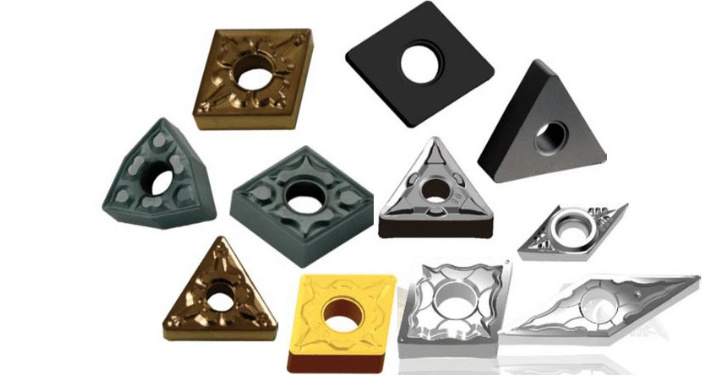はじめに現代機械加工の最先端
効率と精度のあくなき追求の中で、機械加工の世界は次のような革命を遂げた。 超硬インサートs.この小さいが強力な切削工具は、比類のない硬度、耐摩耗性、汎用性を提供し、材料除去プロセスを再定義しました。この包括的なガイドでは、超硬チップの世界を深く掘り下げ、その組成、用途、利点、そしてお客様の加工ニーズに最適なチップを選択するための主な考慮事項を探ります。
超硬インサートを理解する:超硬インサートとは?
ツールの定義
A 超硬インサート 超硬合金は、その優れた硬度と耐摩耗性で知られる複合材料です。これらのチップは、刃先交換可能な複数の切れ刃(フェース)を備えているため、1つのチップで迅速な交換と複数回の使用が可能です。工具ホルダーにしっかりと固定されるため、加工時の安定性と精度が向上します。

超硬インサートの主な利点:
- 並外れた硬度: 超硬合金は、その固有の硬度により、焼き入れ鋼、鋳鉄、高温合金など、さまざまな材料の加工が可能です。
- 優れた耐摩耗性: 超硬チップは優れた耐摩耗性を発揮し、工具寿命を延ばし、工具交換のためのダウンタイムを短縮します。
- 高温安定性: 高速加工時に発生する高温下でも切れ味と寸法安定性を維持します。
- インデクサブル・デザイン: 1つのチップに複数の切れ刃があるため、刃先交換が可能で、工具の利用率を最大化し、コストを削減できる。
- 汎用性がある: 旋盤加工、フライス加工、溝入れ加工、ねじ切り加工など、さまざまな機械加工に対応できるよう、さまざまな形状、サイズ、形状が用意されている。
さらに深く種類、等級、形状
選択の世界:
超硬チップには、特定の材料や加工工程に最適化された、多種多様なタイプがあります。一般的なタイプには、以下のようなものがある:
- ターニングインサート: 円筒ターニング、フェーシング、プロファイル加工に使用。
- フライス用インサート: 平面、溝、輪郭のフライス加工用。
- 溝入れインサート: 溝、溝、凹みの加工に特化。
- ねじ切りインサート: 内ねじ、外ねじの切削に使用。
超硬合金の等級を理解する:
超硬材種とは、超硬合金の特定の組成と特性を指す。異なる材種は、特定の材料グループや加工条件に合わせて設計されています。
- Cグレード: 鋼、ステンレス鋼、鋳鉄の加工に適した汎用鋼種。
- Mグレード: ステンレス鋼、高温合金、その他の難削材の加工に最適。
- 小学校高学年 鋳鉄、非鉄金属、非金属材料の加工用に設計。
- Pグレード: 特に高速加工と仕上げ作業用に設計されている。
インサート・ジオメトリーの解読
すくい角、逃げ角、チップブレーカなどのチップ形状は、切りくずの形成、切りくずの排出、仕上げ面に重要な役割を果たします。
- レーキの角度: 切削抵抗、切りくずの厚さ、仕上げ面に影響する。正のすくい角は、切削力を減少させるが、切れ刃を弱くする可能性がある。
- クリアランスアングル: 切屑排出のためのスペースを確保し、チップとワークの擦れを防ぐ。
- チップブレーカー 切屑の形成を制御し、切屑の流れを切削領域から遠ざける、チップ面の溝またはくぼみ。
業界を超えたアプリケーション高精度と性能の融合
主要部門における効率化の推進:
超硬チップは、以下のような幅広い産業で不可欠な工具です:
- 自動車: エンジンブロック、シリンダーヘッド、トランスミッション部品、その他高精度と耐久性が要求される重要部品を製造。
- 航空宇宙 タービンブレード、エンジン部品、着陸装置、および卓越した強度と信頼性が要求される構造部品を製造。
- 医療機器製造: 厳しい公差と生体適合性を必要とするインプラント、手術器具、その他の医療機器の製造。
- エネルギーだ: 石油・ガス探査、発電、再生可能エネルギーシステム用部品の機械加工。
- 製造業全般: 機械工場、加工施設、製造工場で、さまざまな機械加工作業に広く使用されている。
サプライヤーの比較超硬インサート市場のナビゲーション
| サプライヤー | 所在地 | 価格帯(1枚あたり) | 特産品 |
|---|---|---|---|
| サンドビック・コロマント | スウェーデン | $10 – $50+ | 様々な用途、高度なコーティング、形状に対応する幅広いチップラインナップ |
| ケナメタル | アメリカ | $8 – $40+ | 要求の厳しいアプリケーション用の高性能チップ、革新的なツーリングソリューション |
| TRUER | 中国 | $7 – $35+ | 多様なインサート形状、費用対効果の高いソリューション、研究開発への強いこだわり |
| 三菱マテリアル | 日本 | $9 – $45+ | 高品質のチップ、高度なコーティング、特定産業向けの特殊工具 |
長所と短所の比較:利点と限界
| メリット | 制限事項 |
|---|---|
| 卓越した硬度と耐摩耗性 | ハイス工具に比べてイニシャルコストが高い |
| 高温安定性と耐酸化性 | 衝撃荷重を受けると脆くなり、欠けやすくなる。 |
| 工具を最大限に活用できる刃先交換式設計 | 特定のツールホルダーシステムが必要 |
| 様々な用途に対応する幅広いグレード、形状、コーティング | 最適な性能を得るには、適切な選択と適用が重要 |
TRUERの違い:超硬インサートのニーズで当社を選ぶ理由
最先端技術のリーダーとの提携:
- 妥協のない品質: 当社では、信頼できるメーカーから超硬チップを調達しており、安定した品質と性能を保証しています。
- アプリケーション固有の専門知識: 当社の経験豊富なエンジニアチームが、お客様の加工ニーズに最適なチップの選定をご案内します。
- 競争力のある価格とタイムリーな配達: 競争力のある価格設定と迅速な納品で、ダウンタイムを最小限に抑え、お客様の生産性を最大限に高めます。
よくある質問超硬インサートに関するお問い合わせ
1.用途に適した超硬材種はどのように選べばよいですか?
加工する材料、加工作業の種類、希望する工具寿命を考慮してください。サプライヤーのカタログを参照するか、専門家の助言を得て、最適な材種を決定する。
2.インサート形状の選択に影響を与える要因は何ですか?
その要因には、加工する材料、切り込み深さ、希望する仕上げ面、工作機械の能力などがある。
3.超硬チップの割り出しや交換のタイミングは、どうすればわかりますか?
摩耗の兆候には、切削力の増大、表面仕上げの不良、過度の発熱、刃先のチッピングや破損などがある。
4.コーティングされた超硬チップを使用する利点は何ですか?
コーティングは、工具寿命、硬度、耐摩耗性、耐酸化性を向上させ、切削速度の高速化と生産性の向上を可能にする。
5.超硬チップの適切なメンテナンスと保管方法は?
インサートは、衝撃や湿気から保護された、清潔で乾燥し た環境で保管してください。切り屑や破片を取り除くには、適切なチップ・ブラシや洗浄方法を使用する。




